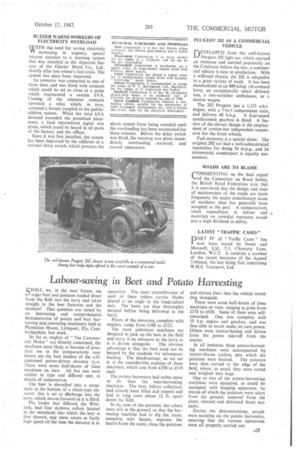Labour-saving in Beet and Potato Harvesting S HALL we, in the
Page 29

If you've noticed an error in this article please click here to report it so we can fix it.
near future, see sugar beet and potatoes loaded direct from the field into the lorry and taken straight to the beet factories and the markets? That question was raised by an interesting and comprehensive demonstration of potato and beet harvesting and conveying machinery held at Plantation House, Littleport, Ely, Cambridgeshire, last week.
So far as reatiers of "The Commercial Motor" are directly concerned, the machines most likely to become of practical use in the comparatively near future are the beet loaders of the selfcontained power-driven elevator ty;:e. There were some half-dozen of these machines on view. All but one were similar in type and differed only in details of construction.
The beet is shovelled into a receptacle at the bottom of a chain-type elevator; this is set to discharge into the lorry, which moves forward as it is filled, The *loader that differed, the Whitlock, had four skeleton rollers located in the receptacle into which the beet is first thrown, and these rotate at fairly high speed all thetime the elevator is in operation. The outer circumference of each of these rollers carries blades placed at an angie to the longitudinal axis. The beets are thus thoroughly scraped before being delivered to the lorry.
Prices of the elevators, complete with engines, range from £100 to £222.
The more ambitious machines are designed to pick up the beet in the field and carry it on elevators to the lorry as it is driven alongside. The obvious advantage is that the beet need not be heaped by the roadside for subsequem loading. The disadvantage, as we see it, is the considerable expense of these machines, which cost from £350 to £510 each.
The potato harvesters had rather more to do than the beet-harvesting machines. The beet, before collection, had already been lifted and topped and laid in long rows about 12 ft. apart down the field.
In the case of the potatoes, the tubers were still in the ground, so that the harvesting machine had to dig the roots, complete wito haulm, separate the haulm from the roots, clean the potatoes
and elevate theta into the vehicle travelling alongside.
There were some half-dozen of these machines or view, ranging in price from £378 to £950. Some of them were selfcontained. One was complete with 10 h.p. engine and gearbox, and was thus able to travel under its own power. Others were tractor-hauled and driven from the power take-off from the tractor.
In all instances these potato-harvesting machines were accompanied by tractor-drawn traiters, into which the potatoes were hoisted, The potatoes were then carried to the edge of the field, where, as usual, they were sorted and weighed into bags.
One or two of the potato-harvesting machines were equipped, or could be equipped, with bagging apparatus, by means of which the potatoes were taken from the ground, removed from the plant, cleaned and delivered direct into sacks.
During the demonstrations, people were standing on the potato harvesters, ensuring that the various operations were all property carried out.












































































